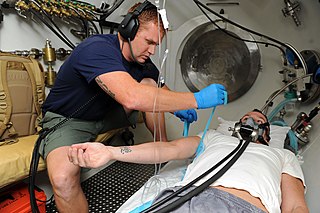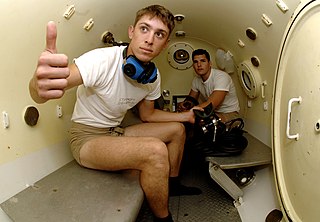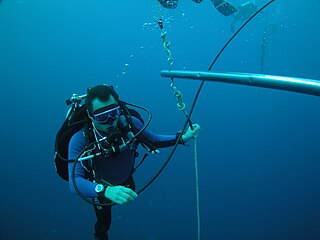Related Research Articles

Decompression sickness is a medical condition caused by dissolved gases emerging from solution as bubbles inside the body tissues during decompression. DCS most commonly occurs during or soon after a decompression ascent from underwater diving, but can also result from other causes of depressurisation, such as emerging from a caisson, decompression from saturation, flying in an unpressurised aircraft at high altitude, and extravehicular activity from spacecraft. DCS and arterial gas embolism are collectively referred to as decompression illness.
Decompression Illness (DCI) comprises two different conditions caused by rapid decompression of the body. These conditions present similar symptoms and require the same initial first aid. Scuba divers are trained to ascend slowly from depth to avoid DCI. Although the incidence is relatively rare, the consequences can be serious and potentially fatal, especially if untreated.

Saturation diving is diving for periods long enough to bring all tissues into equilibrium with the partial pressures of the inert components of the breathing gas used. It is a diving mode that reduces the number of decompressions divers working at great depths must undergo by only decompressing divers once at the end of the diving operation, which may last days to weeks, having them remain under pressure for the whole period. A diver breathing pressurized gas accumulates dissolved inert gas used in the breathing mixture to dilute the oxygen to a non-toxic level in the tissues, which can cause potentially fatal decompression sickness if permitted to come out of solution within the body tissues; hence, returning to the surface safely requires lengthy decompression so that the inert gases can be eliminated via the lungs. Once the dissolved gases in a diver's tissues reach the saturation point, however, decompression time does not increase with further exposure, as no more inert gas is accumulated.

Diving medicine, also called undersea and hyperbaric medicine (UHB), is the diagnosis, treatment and prevention of conditions caused by humans entering the undersea environment. It includes the effects on the body of pressure on gases, the diagnosis and treatment of conditions caused by marine hazards and how relationships of a diver's fitness to dive affect a diver's safety. Diving medical practitioners are also expected to be competent in the examination of divers and potential divers to determine fitness to dive.
Diving disorders, or diving related medical conditions, are conditions associated with underwater diving, and include both conditions unique to underwater diving, and those that also occur during other activities. This second group further divides conditions caused by exposure to ambient pressures significantly different from surface atmospheric pressure, and a range of conditions caused by general environment and equipment associated with diving activities.
In diving and decompression, the oxygen window is the difference between the partial pressure of oxygen (PO2) in arterial blood and the PO2 in body tissues. It is caused by metabolic consumption of oxygen.
In physiology, isobaric counterdiffusion (ICD) is the diffusion of different gases into and out of tissues while under a constant ambient pressure, after a change of gas composition, and the physiological effects of this phenomenon. The term inert gas counterdiffusion is sometimes used as a synonym, but can also be applied to situations where the ambient pressure changes. It has relevance in mixed gas diving and anesthesiology.

Captain Albert Richard Behnke Jr. USN (ret.) was an American physician, who was principally responsible for developing the U.S. Naval Medical Research Institute. Behnke separated the symptoms of Arterial Gas Embolism (AGE) from those of decompression sickness and suggested the use of oxygen in recompression therapy.
Albert Alois Bühlmann was a Swiss physician who was principally responsible for a number of important contributions to decompression science at the Laboratory of Hyperbaric Physiology at the University Hospital in Zürich, Switzerland. His impact on diving ranged from complex commercial and military diving to the occasional recreational diver. He is held in high regard for his professional ethics and attention to his research subjects.
Hyperbaric nursing is a nursing specialty involved in the care of patients receiving hyperbaric oxygen therapy. The National Board of Diving and Hyperbaric Medical Technology offers certification in hyperbaric nursing as a Certified Hyperbaric Registered Nurse (CHRN). The professional nursing organization for hyperbaric nursing is the Baromedical Nurses Association.

The decompression of a diver is the reduction in ambient pressure experienced during ascent from depth. It is also the process of elimination of dissolved inert gases from the diver's body which accumulate during ascent, largely during pauses in the ascent known as decompression stops, and after surfacing, until the gas concentrations reach equilibrium. Divers breathing gas at ambient pressure need to ascend at a rate determined by their exposure to pressure and the breathing gas in use. A diver who only breathes gas at atmospheric pressure when free-diving or snorkelling will not usually need to decompress. Divers using an atmospheric diving suit do not need to decompress as they are never exposed to high ambient pressure.

To prevent or minimize decompression sickness, divers must properly plan and monitor decompression. Divers follow a decompression model to safely allow the release of excess inert gases dissolved in their body tissues, which accumulated as a result of breathing at ambient pressures greater than surface atmospheric pressure. Decompression models take into account variables such as depth and time of dive, breathing gasses, altitude, and equipment to develop appropriate procedures for safe ascent.

Decompression in the context of diving derives from the reduction in ambient pressure experienced by the diver during the ascent at the end of a dive or hyperbaric exposure and refers to both the reduction in pressure and the process of allowing dissolved inert gases to be eliminated from the tissues during this reduction in pressure.

Decompression theory is the study and modelling of the transfer of the inert gas component of breathing gases from the gas in the lungs to the tissues and back during exposure to variations in ambient pressure. In the case of underwater diving and compressed air work, this mostly involves ambient pressures greater than the local surface pressure, but astronauts, high altitude mountaineers, and travellers in aircraft which are not pressurised to sea level pressure, are generally exposed to ambient pressures less than standard sea level atmospheric pressure. In all cases, the symptoms caused by decompression occur during or within a relatively short period of hours, or occasionally days, after a significant pressure reduction.
Compression arthralgia is pain in the joints caused by exposure to high ambient pressure at a relatively high rate of compression, experienced by underwater divers. Also referred to in the U.S. Navy Diving Manual as compression pains.

The thermodynamic model was one of the first decompression models in which decompression is controlled by the volume of gas bubbles coming out of solution. In this model, pain only DCS is modelled by a single tissue which is diffusion-limited for gas uptake and bubble-formation during decompression causes "phase equilibration" of partial pressures between dissolved and free gases. The driving mechanism for gas elimination in this tissue is inherent unsaturation, also called partial pressure vacancy or the oxygen window, where oxygen metabolised is replaced by more soluble carbon dioxide. This model was used to explain the effectiveness of the Torres Straits Island pearl divers empirically developed decompression schedules, which used deeper decompression stops and less overall decompression time than the current naval decompression schedules. This trend to deeper decompression stops has become a feature of more recent decompression models.

The physiology of decompression is the aspect of physiology which is affected by exposure to large changes in ambient pressure. It involves a complex interaction of gas solubility, partial pressures and concentration gradients, diffusion, bulk transport and bubble mechanics in living tissues. Gas is breathed at ambient pressure, and some of this gas dissolves into the blood and other fluids. Inert gas continues to be taken up until the gas dissolved in the tissues is in a state of equilibrium with the gas in the lungs, or the ambient pressure is reduced until the inert gases dissolved in the tissues are at a higher concentration than the equilibrium state, and start diffusing out again.
Inner ear decompression sickness, (IEDCS) or audiovestibular decompression sickness is a medical condition of the inner ear caused by the formation of gas bubbles in the tissues or blood vessels of the inner ear. Generally referred to as a form of decompression sickness, it can also occur at constant pressure due to inert gas counterdiffusion effects.
References
- 1 2 3 4 5 6 7 8 9 10 11 Hills, Y; Fock, A. (2006). "Obituary: Brian Andrew Hills". Diving and hyperbaric medicine. 36 (2): 111–112.
- 1 2 3 4 5 6 7 8 9 Doolette, DJ (2006). "A personal view of Brian Hills' contribution to decompression theory and practice". Diving and hyperbaric medicine. Archived from the original on 8 February 2020. Retrieved 28 April 2016.
{{cite journal}}: CS1 maint: unfit URL (link) - 1 2 3 4 5 6 7 8 9 Hills, BA (2002). "The early days of hyperbaric research in Adelaide" (PDF). Journal of the South Pacific Underwater Medicine Society. Reprint from Offgassing 2002. South Pacific Underwater Medicine Society. p. 89. Retrieved 3 May 2016.